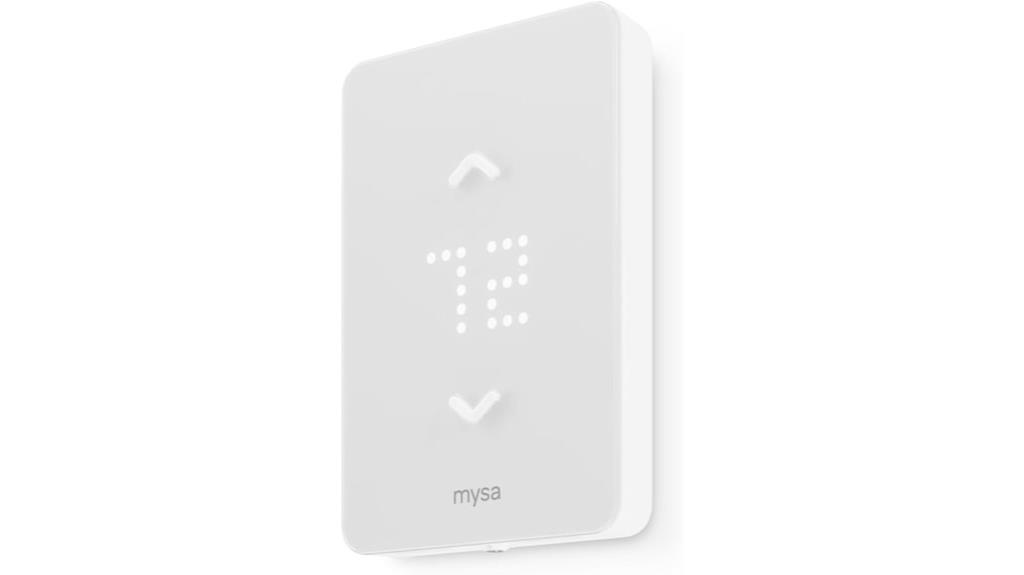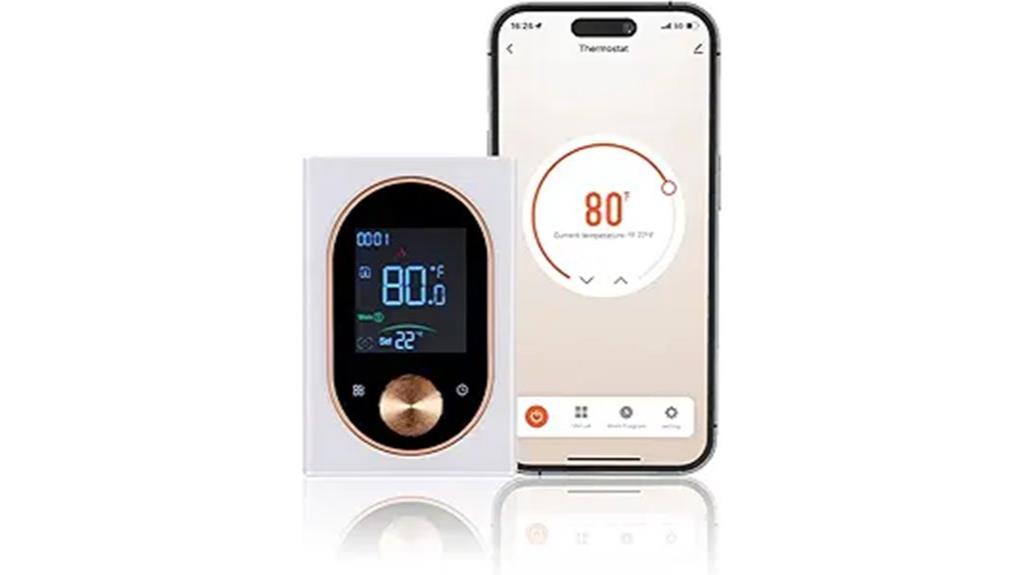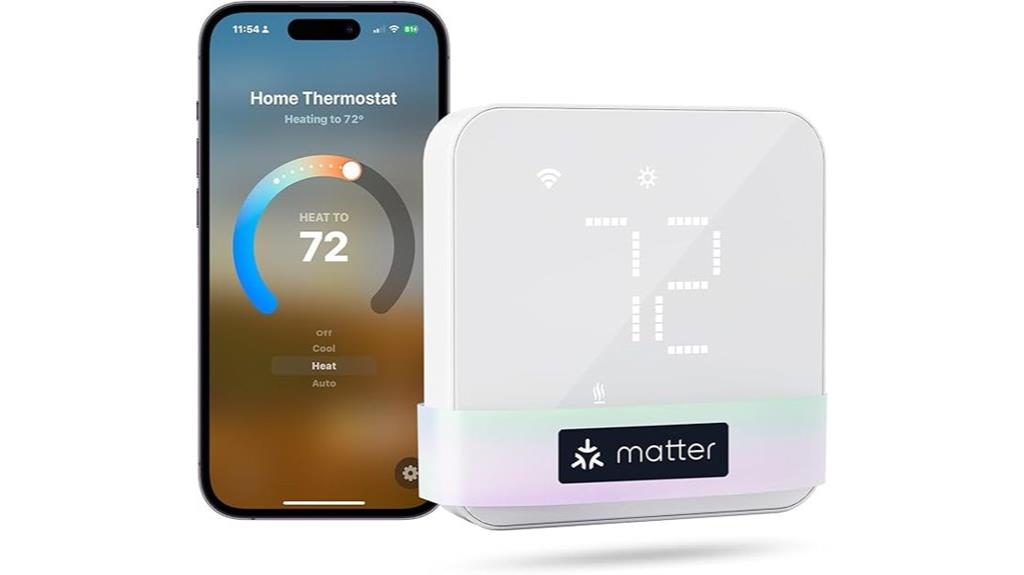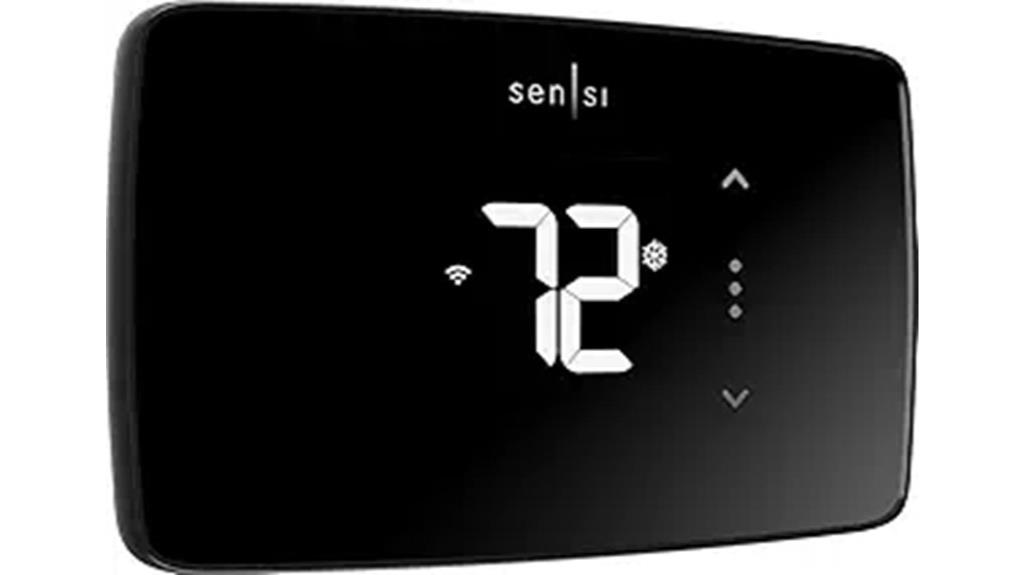If you’re looking for the best smart thermostats for baseboard heaters in 2025, I recommend options like Mysa, meross, and Honeywell, which offer easy installation, app control, and energy-saving features. These models support high wattage loads, work with popular voice assistants, and integrate with smart home platforms. Choosing the right one depends on your wiring setup and preferred ecosystem. Keep exploring, and you’ll find all the details to make the best choice for your home.
Key Takeaways
- Compatibility with high-voltage baseboard heaters (120V/240V) and support for up to 3800W ensures optimal performance.
- Seamless integration with popular smart home ecosystems like Apple HomeKit, Alexa, and Google Assistant enables versatile control.
- User-friendly installation, setup, and manual controls facilitate quick DIY setup and easy operation.
- Key features such as scheduling, energy monitoring, and remote control deliver energy savings and enhanced comfort.
- Reliable Wi-Fi connectivity and multi-platform compatibility are essential for effective automation and voice control.
Mysa Smart Thermostat LITE for Baseboard Heaters

If you’re looking for an easy-to-install smart thermostat that maximizes energy savings and is compatible with various baseboard heaters, the Mysa Smart Thermostat LITE is an excellent choice. It controls line voltage electric heaters, including baseboards, fan-forced units, and convectors, in 120V or 240V setups. Installation takes about 15 minutes with a simple DIY process, no electrician needed. The sleek, durable design features a 2-year warranty and UL safety certification. With Wi-Fi connectivity, you can control your heating remotely, set schedules, and monitor energy use. It also integrates seamlessly with Apple HomeKit, Alexa, and Google Assistant, making smart home automation effortless.
Best For: homeowners and DIY enthusiasts seeking an easy-to-install, energy-efficient smart thermostat compatible with various line voltage baseboard heaters.
Pros:
- Quick and simple DIY installation in approximately 15 minutes without needing an electrician.
- Compatible with major smart home platforms like Apple HomeKit, Alexa, and Google Assistant for seamless automation.
- Helps reduce heating costs by up to 26% through customizable scheduling and energy management features.
Cons:
- Limited to line voltage electric heaters; not suitable for low-voltage systems or other heating types.
- Requires a Wi-Fi connection for remote features, which may be a concern in areas with poor connectivity.
- Only available in 120V and 240V configurations, so compatibility must be confirmed before purchase.
meross Smart Thermostat for Electric Baseboard and In-Wall Heaters

The meross Smart Thermostat stands out as an excellent choice for homeowners with high-voltage electric baseboard and wall heaters seeking reliable, app-controlled temperature management. It supports 120V-240V systems with a maximum load of 16A, offering precise control from 41℉ to 95℉. Its sleek LCD display and wall-mount design blend seamlessly into any home decor. Compatible with Apple HomeKit, Alexa, Google Assistant, and SmartThings, it’s easy to integrate into existing smart setups. Installation is straightforward, and the app provides scheduling, energy monitoring, and open window detection. Overall, it’s a feature-rich, reliable option for managing electric heating efficiently.
Best For: homeowners with high-voltage electric baseboard or wall heaters seeking precise, app-controlled temperature management and smart home integration.
Pros:
- Compatible with Apple HomeKit, Alexa, Google Assistant, and SmartThings for versatile voice and app control
- Supports 120V-240V systems with a maximum load of 16A, suitable for various high-voltage heating setups
- Features scheduling, energy monitoring, and open window detection for efficient and customizable heating management
Cons:
- Does not support underfloor heating, despite some claims
- Limited to control of a single location as the app lacks multi-site management
- Wiring installation can be complex in older homes, sometimes requiring trial and error during setup
Mysa Smart Thermostat for Electric Baseboard Heaters

For homeowners seeking precise control and energy savings, the Mysa Smart Thermostat stands out as an excellent choice for electric baseboard heaters. Designed for high-voltage systems, it supports loads up to 3800W at 240V and works with 120V setups, requiring at least four wires, including a neutral. Its sleek, minimalist design blends seamlessly into walls, while the 3.5-inch adaptive brightness display offers easy monitoring. Setup is quick, guided by the app, which also provides scheduling, zone control, and energy insights. Compatible with Alexa, Google Assistant, and Apple HomeKit, Mysa delivers intuitive control, helping you optimize comfort and efficiency effortlessly.
Best For: homeowners with high-voltage electric baseboard heating systems seeking precise control, energy savings, and smart home integration.
Pros:
- Seamless compatibility with high-voltage electric heaters up to 3800W at 240V and supporting 120V setups
- Intuitive app with scheduling, zone control, energy insights, and voice control via Alexa, Google Assistant, and Apple HomeKit
- Sleek, minimalist design with an adaptive brightness display that blends into wall decor
Cons:
- Requires at least four wires, including a neutral, which may not be available in older or simpler wiring setups
- Higher price point compared to traditional thermostats, which some users find expensive
- Limited to high/line voltage systems; not suitable for low-voltage or two-wire configurations
MOES Programmable Smart Thermostat for Electric Baseboard Heaters

Looking for a smart thermostat that effortlessly manages electric baseboard heaters while integrating seamlessly with your smart home? The MOES Programmable Smart Thermostat is a solid choice. It connects easily with 2.4G WiFi, Alexa, Google Home, and the TUYA/Smart Life app, allowing remote control from your phone. Designed for high-voltage systems, it requires at least four wires, including a neutral or second live wire. Its frosted display reduces glare, and the easy-grip knob makes manual adjustments simple. With scheduling, automation, and voice control capabilities, it helps you save energy and stay comfortable, all while fitting into your existing electrical setup.
Best For: homeowners with electric baseboard heating systems seeking a WiFi-enabled smart thermostat that integrates with voice assistants and offers energy-efficient control.
Pros:
- Compatible with 2.4G WiFi, Alexa, Google Home, and TUYA/Smart Life app for versatile connectivity.
- Features a frosted display and easy-grip knob for simple manual adjustments.
- Supports scheduling, automation, and remote control to optimize comfort and energy savings.
Cons:
- Requires at least four wires, including neutral or second live wire, which may complicate installation in some setups.
- Designed specifically for high-voltage systems, limiting compatibility with lower-voltage applications.
- May require familiarity with smart home apps and wiring to install correctly.
meross Smart Thermostat for Home, WiFi Thermostat

If you want a flexible, Wi-Fi-enabled thermostat compatible with most HVAC systems, the meross Smart Thermostat (Model MTS300) is an excellent choice. It works with 95% of systems, including heat pumps, conventional heating, and cooling setups, but not electric baseboards. Installation is straightforward, taking less than 30 minutes, especially if you have a C-wire or use the Meross adapter. It supports 2.4GHz Wi-Fi and integrates with Apple Home, Amazon Alexa, Google Home, and Samsung SmartThings via Matter. With remote control, scheduling, and smart alerts, it helps optimize your energy use and keep your system running efficiently.
Best For: homeowners seeking a versatile, easy-to-install Wi-Fi thermostat compatible with most HVAC systems and integrated with popular smart home platforms.
Pros:
- Supports 95% of HVAC systems, including heat pumps and conventional setups
- Easy DIY installation under 30 minutes with C-wire or adapter
- Integrates seamlessly with Apple Home, Alexa, Google Home, and Samsung SmartThings via Matter
Cons:
- Not compatible with electric baseboard heaters
- Supports only 2.4GHz Wi-Fi networks, not 5GHz
- Requires a C-wire for proper operation, which may not be available in all homes
Wi-Fi Smart Thermostat for Electric Baseboard Heaters

The Wi-Fi Smart Thermostat for Electric Baseboard Heaters stands out thanks to its seamless remote control capabilities, allowing users to manage their heating from anywhere using a smartphone app. It’s designed for 120-240V systems, with easy installation using included components and a custom wall plate. The LCD screen displays essential info like current and target temperatures, time, and Wi-Fi status. Compatible with Alexa and Google Assistant, it responds to voice commands. This thermostat helps save energy by scheduling and overriding programs as needed, while maintaining a safe temperature to prevent pipe freezing. Perfect for rentals or vacation homes, it offers reliable, flexible control wherever you are.
Best For: those seeking a reliable, remote-controlled smart thermostat to manage electric baseboard heaters in homes, rentals, or vacation properties.
Pros:
- Easy installation with all necessary components and a custom wall plate included.
- Compatible with Alexa and Google Assistant for voice control and automation.
- Helps reduce energy costs through scheduling and manual overrides, while preventing pipe freezing.
Cons:
- Limited to 120-240V systems; not suitable for 24V central heating or single pole setups.
- Requires a 2.4 MHz Wi-Fi network for operation, which may be incompatible with some networks.
- LCD display may be less visible in bright sunlight or from certain angles.
Sensi Lite Smart Thermostat

The Sensi Lite Smart Thermostat stands out as an excellent choice for homeowners seeking an easy-to-install, energy-efficient solution for controlling baseboard heaters. It’s ENERGY STAR certified and compatible with most HVAC systems, requiring only a C-wire in specific setups. Its Wi-Fi capability allows remote management via Android and iOS apps, with features like auto changeover, daylight savings, and usage reports to enhance efficiency. Installation is straightforward, thanks to built-in level and step-by-step instructions. With a sleek LCD backlight display, optional manual control, and a 3-year battery life, the Sensi Lite offers convenience, privacy, and significant energy savings—all in a compact design.
Best For: homeowners seeking an easy-to-install, energy-efficient smart thermostat compatible with most HVAC systems and remote control capabilities.
Pros:
- ENERGY STAR certified, helping to reduce energy costs by approximately 23%
- Easy DIY installation with built-in level and step-by-step instructions
- Compatible with popular smart home platforms like Alexa, Google Assistant, and SmartThings
Cons:
- Requires a C-wire only for certain HVAC configurations, which may necessitate additional wiring in some setups
- Limited to Wi-Fi connectivity; does not support other smart home protocols natively
- The display relies on batteries, which may need replacement after several years
Honeywell Wi-Fi Smart Color Thermostat

For those seeking a customizable and user-friendly smart thermostat, the Honeywell Wi-Fi Smart Color Thermostat stands out with its vibrant color options and intuitive touchscreen. It’s easy to operate, supporting flexible programming and utility peak rate pricing for added savings. Compatible with most heat/cool oil systems and supporting smart home integrations like Alexa and Google, it offers remote control from anywhere via the app. Its Energy Star certification helps monitor and reduce energy consumption, while personalization options let you match the décor. Just keep in mind, it requires a C-wire and doesn’t support electric baseboard heat. Overall, it’s a versatile, stylish choice for modern home heating control.
Best For: Homeowners seeking a customizable, stylish, and easy-to-use smart thermostat compatible with a variety of heating systems and smart home integrations.
Pros:
- Vibrant color options and intuitive touchscreen for personalized style and easy operation
- Supports flexible programming, energy monitoring, and utility rebate opportunities
- Compatible with Amazon Alexa, Google Home, and remote app control for convenience
Cons:
- Requires a C-wire for installation, which may not be present in all homes
- Does not support electric baseboard heat (120-240V) or electric-only heating systems without a C-wire
- Limited to certain HVAC systems; may not be suitable for all forced air or oil systems
Factors to Consider When Choosing a Baseboard Heater Thermostat Smart Control

When choosing a smart thermostat for your baseboard heater, I consider compatibility with my heating system to make certain it works seamlessly. I also look for reliable Wi-Fi features, ease of installation, and how well it integrates with my smart home setup. Finally, I prioritize energy-saving functions to help reduce my bills and environmental impact.
Compatibility With Heating Systems
Choosing a smart thermostat for your baseboard heaters requires guaranteeing compatibility with your heating system’s specific electrical and wiring setup. Most baseboard heaters operate on line voltage systems, usually 120V or 240V, so your thermostat must support these voltages. It’s also crucial to verify that it works with your heater type, whether convectors, fan-forced, or radiant ceiling models. Check if the thermostat needs a neutral or second live wire—many line voltage systems require this for proper operation. Additionally, confirm that the thermostat can handle your heater’s maximum wattage load to avoid overloads. Finally, ensure your home’s wiring configuration aligns with the thermostat’s requirements to prevent installation issues or potential damage. Compatibility is key to safe, efficient operation.
Wi-Fi Connectivity Features
Wi-Fi connectivity features are a game-changer for managing your baseboard heaters, allowing you to control and monitor your thermostat remotely through smartphone apps. With reliable Wi-Fi, you can make real-time adjustments, guaranteeing your home stays comfortable without delays. Compatibility with standard networks, like 2.4GHz or 5GHz, is vital for seamless pairing and stable operation. Many smart thermostats also support integration with voice assistants such as Alexa, Google Assistant, and Apple HomeKit, enabling hands-free control. However, a strong Wi-Fi signal and proper network setup are essential to avoid connectivity issues that could disrupt your heating schedules or remote access. Prioritizing these features ensures smooth operation and reliable control, no matter where you are.
Installation Ease and Setup
Selecting a thermostat that’s easy to install can save you both time and frustration. Look for models with clear, straightforward wiring instructions to simplify the DIY process. Opt for thermostats that have quick setup procedures, ideally taking less than 30 minutes, so you don’t get bogged down during installation. A thorough app or video guide is also helpful, guiding you through configuration and zone control easily. Make sure the device is compatible with your existing wiring, whether it needs four wires, a neutral, or a second live wire, to ensure proper operation. Additionally, choose thermostats with user-friendly interfaces—large displays and minimal controls—to make adjustments simple during installation. These features can make setup smoother and more accessible for everyone.
Smart Home Integration
To guarantee your smart thermostat works seamlessly with your existing smart home setup, it’s essential to verify its compatibility with your preferred ecosystem, such as Apple HomeKit, Amazon Alexa, Google Assistant, or Samsung SmartThings. Make sure the thermostat supports voice control integration so you can adjust temperatures hands-free. Check if it can be controlled remotely through a dedicated app, allowing management from anywhere with internet access. Compatibility with automation and scene creation is also vital, enabling your thermostat to work smoothly with other smart devices and routines. Additionally, confirm it supports communication protocols like Wi-Fi, Matter, or Zigbee for reliable integration. These factors ensure your thermostat fits seamlessly into your smart home ecosystem, providing convenience and enhanced control.
Energy Saving Capabilities
Energy saving is a key benefit of smart thermostats, as they actively help reduce heating costs by optimizing how and when your baseboard heaters operate. They can create tailored heating schedules that turn off or lower temperatures when your space isn’t in use, saving energy without sacrificing comfort. Features like geofencing automatically adjust settings based on your location, ensuring heaters run only when needed. Many models offer energy reports and insights, enabling you to identify patterns and cut unnecessary heating. Precise temperature control and quick responsiveness help minimize overheating and waste. Plus, integration with home automation systems allows for coordinated energy management across devices, maximizing efficiency. Overall, these capabilities make smart thermostats an effective tool for reducing energy consumption and lowering your utility bills.
User Interface and Controls
A user-friendly interface makes managing your baseboard heater thermostat straightforward and efficient. Clear displays and intuitive controls let me make quick adjustments without hassle. Touchscreens or physical buttons should offer precise temperature settings and respond promptly to my input. Smartphone apps with simple navigation allow me to control and customize my heating remotely, saving time and effort. Voice control compatibility with Alexa, Google Assistant, or Siri adds hands-free convenience, which is especially helpful when multitasking. Features like child lock, manual override, and adjustable display brightness enhance safety and usability. Overall, the right interface makes certain I can easily operate my thermostat, access essential functions, and enjoy a seamless heating experience.
Price and Warranty Options
When choosing a smart control thermostat for your baseboard heaters, considering the price and warranty options is essential to guarantee you get the best value for your investment. Start by comparing initial costs, as premium models with advanced features often come at a higher price than basic ones. Be aware of any extra costs, like subscription fees or required accessories, which can add up over time. Check the warranty period—some thermostats offer up to two years of coverage, providing peace of mind. Extended warranties or support services can also add value, especially for long-term maintenance. Keep in mind that higher-priced thermostats usually feature better build quality and more extensive functionalities, potentially leading to increased durability and energy savings in the long run.
Frequently Asked Questions
How Do Smart Thermostats Improve Energy Efficiency for Baseboard Heaters?
Smart thermostats improve energy efficiency for baseboard heaters by learning my schedule and adjusting temperatures accordingly, so I don’t waste energy heating when I’m not home. They allow me to set precise schedules and remotely control my heating from my phone, which prevents unnecessary energy use. Plus, they can detect when windows are open or when the room is unoccupied, automatically lowering the heat to save energy.
Can Smart Thermostats Be Integrated With Existing Home Automation Systems?
Imagine your smart thermostat as the conductor of your home’s orchestra—I can tell you, it can definitely be integrated with existing home automation systems. I connected mine seamlessly using compatible hubs, and it felt like adding a new instrument to our symphony. Most modern thermostats support popular platforms like Alexa, Google Home, or Apple HomeKit, making integration straightforward and enhancing overall home control.
What Security Features Are Included in These Smart Thermostats?
Smart thermostats include security features like encrypted data transmission to protect your information and secure login options, such as two-factor authentication. They also often have firmware updates to patch vulnerabilities and device access controls, so only authorized users can make changes. I always recommend choosing models with these security measures to keep your home network safe while enjoying the convenience of smart control.
Are There Compatibility Issues With Specific Baseboard Heater Models?
Did you know that over 60% of homeowners experience compatibility issues with smart thermostats and their existing baseboard heaters? I’ve found that some models don’t work well with certain electric or hydronic baseboard systems. It’s essential to verify the thermostat’s compatibility list before buying. I always recommend consulting with a professional or the manufacturer to ensure seamless integration and avoid costly mistakes.
How User-Friendly Are the Setup and Daily Operation Processes?
Setting up these thermostats is surprisingly straightforward; most come with clear instructions and user-friendly apps. I found that connecting them to my Wi-Fi took just a few minutes, and daily operation involves simple adjustments via the app or touchscreen. The intuitive interfaces make scheduling and temperature control easy, even for beginners. Overall, I think you’ll find the process hassle-free, making it simple to enjoy smart, efficient heating.
Conclusion
Just as Da Vinci once envisioned perfect harmony between art and science, selecting the right smart thermostat brings balance to your home’s comfort and efficiency. With these top choices, you can master your heating like a true maestro, ensuring cozy warmth with a tap or voice command. Remember, the right thermostat isn’t just a tool—it’s your home’s symphony conductor, making every winter day feel just right.









